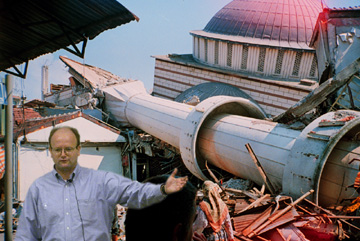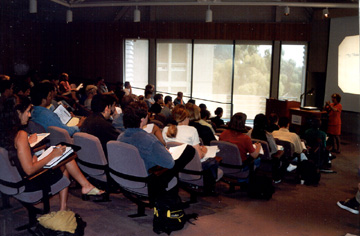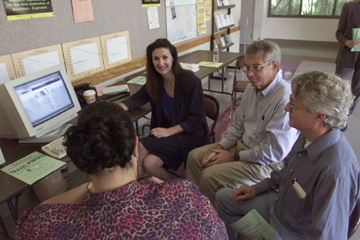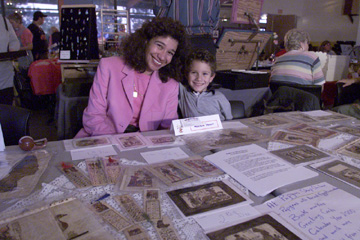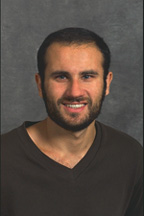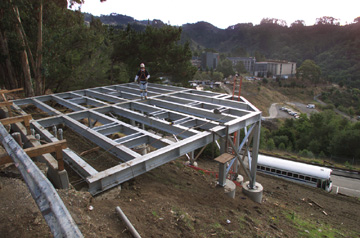
| Celebration Marks Key Milestone In Human DNA Sequencing |
Director Takes Strong Stand Against New Travel Restrictions |
- Celebration Marks Key Milestone In Human DNA Sequencing
- Director Takes Strong Stand Against New Travel Restrictions
- Text of Director Charles Shank's Letter To Deputy Secretary T. J. Glauthier
- Travel Preapproval Procedures
- It's Flat After All . . . The Universe, That Is
- Holiday Party
- Washington Report
- Turkish Earthquake: A Forewarning?
- Former Corporate Executive to Lead UC's Laboratory Advisory Council
- In Memoriam -- Robert Force
- Correction
- Berkeley Lab Currents
- Genentech Settles with UC
- DARHT Passes Key Test
- Postdoc Organizations Prepare Members for New Job Market
- Travel Power: More Options and Lower Fares
- Our Last Odd Day on Earth
- SHARES Campaign A Success
- Bulletin Board
- Calendar of Events
- Funding Opportunities for Small Business Collaborations
- EH&S Classes - December 1999
- New Power Station Goes Up
- Flea Market
- Flea Market Ad Policy
Celebration Marks Key Milestone
In Human DNA Sequencing
By Ron Kolb
Francis Collins, Director of the National Human Genome Research Institute, called it a time to "celebrate dreams" and "the audacity of the imagination."
Donna Shalala, Secretary of Health and Human Services, likened it to "a Cecil B. DeMille production" and "the book of life...it's not an easy read, but what it lacks in plot structure it makes up for in the richness of the content."
Secretary of Energy Bill Richardson cited the "pioneers in what will be nothing less than a hallmark of the new millennium."
Senator Tom Harkin said that nothing has captured the national imagination like it "since the Apollo Project."
And ABC News commentator Robert Krulwich referred to it as "an odo-meter moment."
They were all reflecting on the international Human Genome Project and specifically, the successful completion of sequencing one billion base pairs of DNA - that's one-third of the entire biological blueprint of the human genome. That milestone was reached on Nov. 17, and six days later, the five contributing centers celebrated with a cyberparty via videoconference and the Internet.
Huddled around a TV monitor in the Bldg. 50A-4205 conference room at Berkeley Lab were two dozen members of the DOE's Joint Genome Institute who participated in the interactive event on Nov. 23. The JGI is a consortium of sequencers from the Berkeley, Livermore and Los Alamos national labs.
Richardson, one of the event's primary speakers at the National Academy of Sciences in Washington, acknowledged JGI's 160 million base-pairs contribution to the effort.
The other four centers linked to the broadcast were the Whitehead Institute in Cambridge, Mass., Washington University School of Medicine in St. Louis, Baylor College of Medicine in Houston, and the Sanger Center in Cambridge, England.
Collins said the next milestone will be to complete 90 percent of the entire draft genome sequence by next spring, and to deposit the completed blueprint -- accurate, assembled and mapped -- into public databases by 2003. Armed with this knowledge, biology researchers are expected to transform the way diseases are diagnosed, treated and prevented in the next century.
JGI Director Elbert Branscomb participated in the event in Washington, while his deputy, Trevor Hawkins, led the contingent viewing in Berkeley. Richardson presented Branscomb the JGI award for its contribution to the international effort.
In his remarks Richardson noted that in 1986 the DOE launched the first-ever project to examine the feasibility of sequencing the 3 billion base pairs of human DNA and to identify the 100,000 genes in human chromosomes. When the National Institutes of Health started its genome program two years later, it was in coordination with the DOE.
"The Department of Energy not only plays a key role in the genome project as a science agency, but as a builder of sophisticated research tools needed to reach the genome project's scientific goals," he said.
Four different chemicals, or bases, form the rungs of the ladder that is the DNA molecule, where genetic information is coded. The bases - identified by the letters A, C, G and T - sit in 3 billion pairs on the DNA ladder's steps.
The genome project's goal is to determine the exact order of the pairs and develop tools to analyze the data as it relates to gene development and function.
Amid the celebration, Krulwich added a note of caution to the proceedings. Reminding scientists about the public's fear that good information can also be put to inappropriate use, he urged them to "talk about these fears. They are worth hearing, considering, and answering. Educate whenever you can. Genetics needs champions."
Director Takes Strong Stand Against New Travel Restrictions
By Monica Friedlander
The severe restrictions Congress has placed on Laboratory travel by passing the Energy and Water Development Appropriations bill has caused widespread concern throughout the Laboratory community, particularly among scientists whose work depends on travel for national and international collaborations. Their apprehension is echoed by the top levels of management, who vow to do all they can to alleviate the situation.
In a letter sent last month to Deputy Energy Secretary T. J. Glauthier, Lab Director Charles Shank alerted the DOE to what he called the "catastrophic effect" these "draconian cuts" would have on the Lab's ability to conduct its mission.
The change in policy, Shank wrote, "will be a major setback for our ability to contribute to and participate in the science program of this country...We will have no choice but to severely restrict attendance by our scientists at program reviews held at other universities and national laboratories."
The legislation drastically reduced the total funds allowable for travel by DOE contractors, forcing Berkeley Lab to implement new policies that would reduce Laboratory travel funds by 35 percent. While committing himself to implementing the cuts as required by law, the Director hopes the DOE will take his concerns into consideration and apply legal exemptions to allocate more travel funds to Berkeley Lab. Shank also traveled to Washington and met with DOE and Congressional staffers to discuss this issue.
In his letter to Deputy Glauthier, Shank stressed the unique circumstances of this Laboratory, which demand that scientists here travel more frequently than those at other federal facilities.
"For a California laboratory, 2600 miles distant from Washington, these cuts will isolate us from our agency," Shank wrote. "I sincerely believe that the Congress and the Department of Energy had no idea of the damage that would ensue."
Shank cited the many key international collaborations of which Lab scientists are a part and which necessitate use of offsite facilities. These include the Large Hadron Collider at CERN in Switzerland, Fermilab in Illinois, the Relativisitic Heavy Ion Collider (RHIC) in Brookhaven, New York, and the Sudbury Neutrino Observatory (SNO) in Canada. In addition, Shank wrote, "geologists and geophysicists do their experimental work at oil/gas/remediation work sites. These activities accounted for 20 percent of last year's travel budget. Because travel is an integral part of their research costs, these employees have already used their ingenuity to keep travel costs to a minimum."
The law affects travel plans and procedures at Berkeley Lab in two major ways. First, a cap has been placed on travel expenditures for DOE and its contractors. As a result, Berkeley Lab implemented a set of procedures for travel preapproval in order to insure that the Laboratory stays within its DOE travel allocation.
Secondly, the Laboratory will transition to federal travel regulations (FTR's) for travel rates, which are more restrictive than those that were previously allowed under the Lab's own regulations. (See sidebar for preapproval procedure and information.)
"Travel Services has been working with with the divisions, other laboratories, and Maritz Travel to implement the new policies and procedures necessary to meet these regulations as efficiently as possible," says Louise Millard, acting manager for the Lab's Travel Services Office.
Further information regarding the changes in travel procedures will be published as it becomes available. A response to Director Shank's appeal to the DOE is still pending.
The Laboratory's travel website will be updated shortly to reflect the new policies. Questions regarding procedures may be directed to travelhotline @lbl.gov.
Meanwhile, Lab management say they will continue to pursue this issue. Concluded Shank in his letter to Deputy Glauthier: "I urge you to do whatever you can to mitigate these impacts."
Text of Director Charles Shank's Letter To Deputy Secretary T. J. Glauthier
October 21, 1999
Mr. T. J. Glauthier
Deputy Secretary
U. S. Department of Energy
1000 Independence Avenue, S.W.
Washington, DC 20585
Dear Deputy Secretary Glauthier:
This letter is intended to outline the consequences for Berkeley Lab, the Department of Energy (DOE), and the Nation, of implementing the initial guidance from the DOE for travel targets for FY00.
As requested, we are planning for a 35% reduction. We have just completed an implementation exercise in which we give priority to our obligations on multi-laboratory collaborative projects and the congressional guidance that "This is not meant to restrict trips between laboratories to coordinate on program issues." The impact on the rest of the Laboratory's programs is catastrophic and will be a major setback for our ability to contribute to and participate in the science program of this country. We will, of course, do our part to comply with the guidance. Nevertheless, I want to make clear how dire the impact will be.
Our top priority is to meet our obligations as partners on major multi-laboratory projects: Dual Axis Radiographic Hydrodynamic Test Facility (DARHT), Spallation Neutron Source (SNS), Large Hadron Collider (LHC), KAMLAND, ATLAS, Yucca Mountain, and the maintenance of Energy Sciences Network (ESnet). These accounted for 15% of the Laboratory's travel costs in FY99 which we intend to fund fully in FY00.
Our second priority is to support travel to programs for which the success of our researchers' scientific programs depends on using facilities at other sites. As you know, we have no high energy facility on site, and only the 88-inch Cyclotron for nuclear physicists, so the vast majority of our high energy and nuclear physicists do their research at CERN (Europe), Fermilab (Illinois), RHIC (New York), SNO (Canada), or SLAC (the only local site). In addition, our geologists and geophysicists do their experimental work at oil/gas/remediation work sites. These activities accounted for 20% of last year's travel budget. Because travel is an integral part of their research costs, these employees have already used their ingenuity to keep travel costs to a minimum. We plan to make only a modest reduction in these travel budgets.
This means that the remaining travel activities will have to be reduced by a draconian 60%. We will have no choice but to severely restrict attendance by our scientists at program reviews held at other universities and national laboratories, project progress reviews ("Lehman" reviews), and scientific conferences.
The level of travel cut is such that it will serve to isolate our scientists from the broader scientific community. For a California laboratory, 2600 miles distant from Washington, these cuts will isolate us from our agency. I sincerely believe that the Congress and the Department of Energy had no idea of the damage that would ensue.
I urge you to do whatever you can to mitigate these impacts.
Sincerely,
Charles V. Shank
Travel Preapproval Procedures
Trip authorization and numberEffective last month, trip preapproval is required for all official travel according to each division's internal procedures. Interim Domestic Travel Authorization forms are currently available from division offices or the Lab's Travel Services Office. Travelers will not be reimbursed for travel expenses that have not been preapproved.
Employees are assigned a trip number by their division, which they will need to use when booking travel with the Maritz Travel agency or online with Travel Power. (See article on Page 4 for more on Travel Power, or look up its website at http://www.lbl.gov/Workplace/CFO-Travel/ power.html.)
Transition to Federal Travel Regulations (FTR)
Reimbursement for lodging, meals and incidental expenses (MIE) is limited to FTR rates. The per diem MIE rates, broken down by location, are published at http://policyworks.gov/org/main/mt/ homepage/mtt/perdiem/perd99d.html. When specific cities are not listed, the county rate will apply. In limited circumstances, division directors may authorize exceptions to the published lodging rate (up to a cap level) prior to travel.
For upcoming trips that have already been booked before the new rates went into effect, lodging consistent with FTRs should be arran-ged if it is cost effective to make the changes. Otherwise the reason must be documented and approved by the division director, deputy, business services manager, or division business administrator in order for the employee to receive reimbursement for the expense.
All forms should be submitted to Janice Magee (MS 50-4119, phone 5921, fax 6720), the travel coordinator for the Directorate.
Questions above these or related procedures may be directed to travelhotline@ lbl.gov.
It's Flat After All . . . The Universe, That Is
During a test flight in August 1997, the BOOMERanG balloon-borne telescope mapped fine-scale puckers in the smoothness of the cosmic microwave background (CMB) in a narrow strip of sky. After painstaking analysis at the National Energy Research Computing Center (NERSC), the data detailing these anisotropies were finally released last week.
The analysis revealed a pronounced peak in the CMB power spectrum at an angular scale of about one degree -- strong evidence that the universe is flat, not curved. Instead of having positive curvature like a toy balloon, or negative curvature, like a potato chip, four-dimensional spacetime (in this two-dimensional analogy) is as flat as a sheet of paper.
The new data also suggest the existence of a cosmological constant, a form of countergravitational "dark energy" thought to fill the universe. Albert Einstein proposed the cosmological constant in 1917 but later retracted the idea; it was dramatically resurrected in 1998 when the international Supernova Cosmology Project based at Berkeley Lab, along with the High-Z Supernova Search Team centered in Australia, discovered that the expansion of the universe is not slowing down, as it would be if gravity were not offset, but instead is speeding up.
|
|
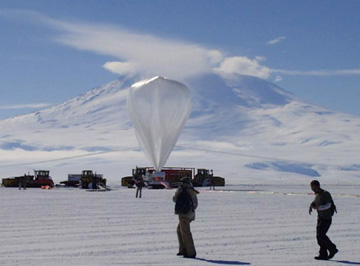 In August 1997, BOOMERanG (left) rose into the evening sky over NASA's National Scientific Balloon Facility in Palestine, Texas for its overnight test flight. Top: Launched on Dec. 29 of last year, BOOMERanG's Long Duration flight circumnavigated the South Pole for ten and a half days, collecting a huge amount of data still being analyzed. |
BOOMERanG stands for "balloon observations of millimetric extragalactic radiation and geophysics," a collaboration of over two dozen researchers from seven countries; its principal investigators are Andrew Lange of the California Institute of Technology and Paolo de Bernardis of the University of Rome, "La Sapienza."
The data acquired during the six-hour test flight from NASA's National Scientific Balloon Facility in Palestine, Texas, were analyzed by NERSC's Julian Borrill, working closely with colleagues at the National Science Foundation's Center for Particle Astrophysics at UC Berkeley and the Canadian Institute of Theoretical Astrophysics at the University of Toronto.
Borrill notes that the data set was so large -- a partial map of the sky covering more than 200 square degrees and containing some 26,000 pixels -- that a one-gigahertz serial processor would have required three months of continuous operation to extract the power spectrum (a measure of the structure of CMB aniso-tropies). By employing the parallel processing power of the Cray T3E supercomputer and using the MADCAP software package he developed at NERSC, Borrill was able to shorten the running time to a matter of hours.
Big as it is, Borrill says, the BOOMERanG North America data set is only the first in a parade of sets "of unprecedented quality and ever-increasing size." The MAXIMA 1 and MAXIMA 2 balloon flights have already produced substantially more data; their analysis is not yet complete.
Late last year, BOOMERanG LDB (for "long duration ballooning") completely circled the South Pole in 10 and a half days, yielding a map of virtually the whole sky visible from the pole, and a data set, whose analysis is underway, that is more than 17 times as large as that of the test flight. Satellites to be launched early next century will produce more data by orders of magnitude; the European Space Agency's PLANCK will map the sky in 10,000,000 pixels.
Cosmology based on CMB experiments entered a new era early in the 1990s, when NASA's Cosmic Background Explorer flew an experiment conceived by astrophysicist George Smoot of the Lab's Physics Division. Smoot's experiment measured small variations in the temperature of the otherwise featureless microwave background for the first time.
The CMB represents the moment -- 300,000 years after the Big Bang -- when temperatures had cooled enough for protons to capture free electrons and form hydrogen atoms. Photons, freed from scattering interactions with electrons, streamed away from the vanished surface of this photon-electron-baryon fluid.
At that instant, some regions in the primordial blob were contracting, heated by compression, while cooler regions were expanding. These motions imprinted temperature differences on the cosmic microwave background. Measuring the smallest possible angles between pairs of warmer or cooler points on a fine-scale map of today's microwave sky yields the CMB power spectrum, a graph that reveals such basic parameters as whether the universe is flat or open.
In a flat universe, with familiar geometry, the oscillations we see today would repeat on a scale of about one degree, because the entire cosmos was equivalent in dimension to a single degree of today's sky. In an open universe, the same oscillations would today appear smaller.
Other information resides in the pattern of anisotropies, but it will only be confirmed when the spectrum is extended: thus the need for ever more detailed maps of the microwave sky.
"The memory required to process these CMB experiments increases as the square of the number of pixels, and the time increases as the cube," Borrill says. "Without new computers and new computational strategies, we won't be able to derive the detailed measurements of basic cosmological parameters the CMB experiments are designed to reveal."
Borrill adds that "because of the power of our parallel machines and the depth of our experience with cosmic microwave background studies, NERSC is becoming the computing center of choice for analyzing CMB data from experiments all over the world. We want to maintain that status, but it will take hard work and fresh ideas."
|
|
The BOOMERanG gondola hangs from the balloon during the flight, scanning back and forth across the sky to map the cosmic microwave background radiation. |
For the latest information on the BOOMERanG experiments, visit the web at http://www.physics.ucsb.edu/~boomerang/. Julian Borrill's MADCAP software, the "microwave anisotropy dataset computational analysis package," is available at http://cfpa.berkeley.edu/~borrill/cmb/madcap.html.
Holiday Party
Lab Cafeteria
Don't forget about Berkeley Lab's annual holiday reception,
to be held on
Thursday, Dec. 16, starting at 3:00 p.m. at the cafeteria.
The event will
include music, food and plenty of holiday spirit.
Washington Report
Record Funding Year for NIHLife sciences researchers everywhere should be pleased with the budget news for the National Institutes of Health, as Congress handed NIH another record budget increase. The $17.9 billion budget passed by the House and Senate represents a $2.3 billion boost that matches last year's pre-cedent-setting 14.7 percent raise. The White House had requested just a three percent increase. "There is a tremendous amount of good news in this budget - it lifts all boats," said Mike Stephens, a spokesperson for the Federation of American Societies for Experimental Biology, which represents more than 66,000 researchers.
Brookhaven Reactor to Close
Citing economics, Energy Secretary Bill Richardson has announced that DOE will shut down the 34-year-old High Flux Beam Reactor at Brookhaven National Laboratory. The HFBR, which has been on "standby" mode since 1996, represents only five percent of the funding within BNL's reactor division.
"Extremely valuable research had been done at this reactor in its 30 years of operation, but it would take years and be costly to restart," Richardson said. The HFBR was placed on standby when it was determined that a tritium leak had contaminated nearby groundwater.
According to DOE science director Martha Krebs, the earliest the reactor could open would be 2002, and there were concerns about its operating capability after such a long layoff.
BNL director John Marburger expressed "deep disappointment" with DOE's decision. "The untimely demise of this powerful research facility leaves a hole in the spectrum of capabilities for which BNL has long been renowned," Marburger said.
Proposed Funding for Earthscope
The National Science Foundation is proposing to spend $75 million towards creating a network of scientific instruments that could be used to analyze the North American continent over a range of spatial and temporal scales. The project, dubbed "EarthScope," would create a downward-looking geophysical "telescope" that would probe the continent from the surface to the core.
NSF's 2001 budget proposal, now under review, would fund two elements of the project: USArray, an assembly of 400 mobile seismometers arranged to blanket a 1000-square kilometer area that would be moved across the nation; and the San Andreas Fault Observatory, a borehole drilled down 4 kilometers into the central San Andreas to find how continental blocks grind past each other to produce earthquakes.--Lynn Yarris
Turkish Earthquake: A Forewarning?
|
|
Former Corporate Executive to Lead UC's Laboratory Advisory Council
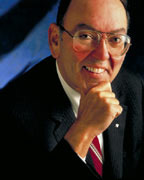
|
| William L. Friend |
William L. (Bill) Friend, a chemical engineer and former corporate executive with Bechtel Group, was named by UC President Richard C. Atkinson to chair the UC President's Council on the National Laboratories. Friend succeeds Stanford physicist Sidney Drell who retired from the council earlier this year.
"The outstanding record of leadership and experience Bill Friend brings to this position will be of significant benefit to the University of California and the Department of Energy laboratories," Atkinson said. "We are grateful for his willingness to chair this important advisory body, and we will value his leadership as the council broadens its perspective and role."
The new appointment will complement changes underway in the Council's oversight of the laboratories. The 20-member panel advises the university on its management of three DOE labs -- Berkeley, Livermore and Los Alamos. The university is currently restructuring the council to place increased emphasis on the oversight of security and management of large-scale projects at these laboratories.
Friend's 41-year career in the international engineering and construction industry includes includes numerous executive-level appointments. For 21 years prior to his retirement in 1998, he was a senior officer at the Bechtel Group, Inc., a leading company in the global engineering and construction industry and a major contractor to government agencies.
Before joining Bechtel, Friend had a distinguished career in process engineering and management. -- Monica Friedlander
In Memoriam -- Robert Force
Robert Force, chief engineer for electrical operations at the Bevatron during its heyday, died on Nov. 17 at the age of 75.
Force joined Berkeley Lab in 1956, shortly after the Bevatron's completion, and stayed on as a consultant after his retirement in the late 1970s, until just before the historic accelerator was shut down in 1993. He is fondly remembered.
Ed Lofgren, who headed the Bevatron until 1979, recalls that Force "frequently had an interesting view of things, sometimes rather humorous. We had a big crew, but he was one of a handful of persons you really counted on."
Roger Dwinell, hired by Force, remembers him as "one of the people who made the Bevatron a good place to work. He was stubborn, and that's one of the things that made him a good guy and an interesting character."
"You always knew where you stood with him," says Gudrun Kleist, who worked for Force on the electronic maintenance crew. "That's what I liked about him. He was a wonderful guy to work for."
Don Milberger went into business with Force in Concord; they soon founded Bicycle Research Products, still going strong. "They say not many partnerships work; ours lasted for almost 30 years."
"He was a cranky, good, tough engineer," says his colleague Jim Greer, "but the most memorable thing about him was his dedication to the Laboratory."
Force, a longtime Berkeley resident, is survived by his wife, Lorraine, by his daughters, Judith Force and Melinda Lunn, and by his grandson, Jonathan Lunn.--Paul Preuss
Correction
The Nov. 19 issue of Currents included a reference to the Paul Scherrer Institute "in Bern, Switzerland." In fact, the institute is in Villigen, Switzerland. We regret the error.
Berkeley Lab Currents
Published twice a month by the Public Information Department for the employees and retirees of Ernest Orlando Lawrence Berkeley National Laboratory. Ron Kolb, PID department head.
EDITOR: Monica Friedlander, (510) 495-2248, msfriedlander@lbl.gov
STAFF WRITERS: Paul Preuss, 486-6249; Lynn Yarris, 486-5375
CONTRIBUTING WRITERS: Jon Bashor, X5849; Allan Chen, X4210, Jeffery Kahn, X4019
FLEA MARKET / CALENDAR: Vikki Davis, 486-5771
fleamarket@lbl.gov / currents_calendar@lbl.gov
Public Information Department, Berkeley Lab, MS 65A
One Cyclotron Road,
Berkeley CA 94720
Tel: 510/486-5771 Fax: 510/486-6641
Berkeley Lab is managed by the University of California for the U.S. Department of Energy.
Genentech Settles with UC
Genentech, the pioneering biotech firm in South San Francisco, has agreed to pay the University of California $200 million to settle a long-running patent suit over the company's $2 billion drug, Protropin. UC has claimed that Genentech had infringed its patent on engineered human growth hormone.
The settlement, which includes a $50 million donation toward a research building at UC San Francisco -- the campus that holds the disputed patent -- will result in payments of $17 million each to five former UCSF scientists.
DARHT Passes Key Test
The Dual-Axis Radiographic Hydrodynamic Test facility, a massive x-ray machine being built under the U.S. stockpile stewardship program to help ensure the safety and reliability of the U.S. nuclear arsenal without the need for nuclear testing, has successfully performed its first hydrodynamic test.
DARHT's specific purpose is to provide freeze-frame photos of materials imploding at speeds of more than 10,000 miles an hour. Its tests are called "hydrodynamic" because metals and other materials flow like liquids when driven by the high pressures and temperatures generated by the detonation of high explosives.
"DARHT's x-rays are as key to the U.S. nuclear stockpile stewardship program as hospital x-rays are to helping to assess the health of the human body," said Energy Secretary Bill Richardson.
The success of this test marks the operational readiness of the first axis of DARHT. When the second axis is completed in 2002, DARHT will provide a more complete picture of what materials are doing as they implode.
The second axis, a much more powerful and sophisticated induction linac, is being designed by researchers at Berkeley Lab's Accelerator and Fusion Research Division.-- Lynn Yarris
Postdoc Organizations Prepare Members for New Job Market
By Steve Sloop
|
Postdoctoral fellows attend a workshop on public and professional |
According to conventional wisdom a postdoctoral position helps a scientist advance into an academic position. In the past, this career path was fairly predictable and reliable. Today's job market, however, has changed the approach postdoctoral students need to take to succeed.
A recent report in Science (Sept. 3, 1999) points out that the number of academic positions has gone down, and as a result, so has the likelihood of obtaining them. On the other hand, there are many rewarding occupations outside of the academic field that are open to postdocs. Therefore, the postdoctoral experience, if well thought-out, continues to offer career opportunities in the academic, business, non-profit and government arenas.
The report in Science, "Postdocs, Working for Respect," points out that many of today's postdocs in the natural sciences will not have academic position 10 years from now and will also tend to make less money than those in other fields. The reason, the article says, is that "so many young scientists are more committed to their work than to financial rewards. They refuse to bail out even when the job market tightens, creating an excess supply that holds down wages."
Commitment to their research, however, can be a plus. Science postdocs can have great jobs over the next 10 years, but only if they identify and transfer their skills to non-academic areas as part of their postdoctoral experience.
Many financial institutions, for example, drool over the skills theoretical astrophysicists have (including writing, computer and data crunching skills). In turn, the postdocs find that type of work fun, lucrative and intellectually stimulating.
During the past few years, postdocs all over the country have organized associations to help them with career plans. The LBNL Postdoctoral Society and the UC Berkeley Postdoctoral Association organized workshops to address grant writing, public speaking, job searching, resume writing, and interdisciplinary networking. In a February workshop on "Getting the First Job," the speaker pointed out that employers utilize a wide variety of interviewing styles to find out about the values, goals and communication skills of their candidates.
Postdoctoral organizations are a natural place to help their members in these areas. They provide a structure to practice job-skills development activities, network in a group of multidisciplinary friends, and express opinions.
Involvement in such an organization can transform a postdoctoral experience into something extraordinary. Postdocs typically interact with scientists, build organization skills, meet people who may hire them, and make friends from all over the world. Finding a place to contribute in the association is just as valuable, and very much like finding a job: matching skills and goals with the functional needs of the organization. Moreover, representing the postdoctoral society when talking to either the academic or non-academic community can often lead to a new career.
During the upcoming year, the Lab and UC postdoctoral organizations are developing another set of workshops which will culminate in the first-ever research conference for LBNL and UCB postdocs. Over the course of two days, postdocs from all scientific disciplines will make presentations and participate in a presentation review process. The conference will include a panel of professionals to provide feedback and encourage interaction between campus and the Lab.
To help make the next year another success for the Lab's postdoc association, look up the organization on the web at http://www.lbl.gov/~postdoc or contact it at postdoc@lbl.gov. Also, plan on attending the association's holiday party on Dec. 9 from 5:30 to 9:00 in the Garden Room of the Clark Kerr Campus.
Travel Power: More Options and Lower Fares
By Monica Friedlander
Given the new travel restrictions at the Laboratory (see story, Page 1), employees are encouraged to use a new tool that helps minimize cost and gives users increased control over their travel plans.Created specifically for Berkeley Lab by a Palo Alto company, Travel Power gives Lab travelers a means to book their business reservations on the web without having to go through an agency. The system incorporates Lab policies into the program and searches for the lowest available fares. It also offers negotiated rates with preferred companies such as United, TWA and National car rental, although employees may book with whichever company offers them the best deals at a given time.
|
|
"I find that when people see the lower fares in color on screen, it's like they have an angel on their shoulder telling them 'do it,'" Redfearn says. "So they book lower fares than when someone on the other end of the phone line tells them what to do."
So far 461 employees at the Lab have signed up to use the system, more than 200 of them following a demonstration held at the cafeteria in October.
Travel Power went online as a pilot program in the spring of 1998 and was purchased by the Lab early this year. Redfearn administers the system, adds users, and makes sure the ticketing is done correctly and the employees get reimbursed.
The Travel Power format has recently been modified to include a field for the trip number. After a booking has been completed, it is submitted to Maritz Travel who will then issue the ticket.
The system was conceived as a "one stop shop," Redfearn says. In addition to making reservations, it also offers services such as currency conversion and translating programs. "It's a complete travel website with the advantage of having specific needs of the Lab incorporated," she says. "And it's fun to use."
The system give quotes for five alternate travel options, searches co-airports (e.g., San Francisco, Oakland, and San Jose for outbound flights), and even allows users to literally see the aircraft they will use and visually pick their seats.
Another advantage is that the program works with United's Apollo live reservation system, seeking seats directly from the airline computer, so that users have live, up to the minute information.
All these factors, Redfearn says, work to give Lab travelers more control over their travel plans.
To use Travel Power, users must sign up by sending an e-mail request to MJRedfearn@lbl.gov. They will then receive a confirmation e-mail with a user ID and password, which will allow them to go online and set up personal profile. Then they are ready to use the system.
Travel Power is for business use only and may not be used to book flights for guests. For more information, look up http://www.lbl.gov/Workplace/CFO-Travel/power.html.
Our Last Odd Day on Earth
It occurred two weeks ago, on 11/19/1999, and most of us let it slip by unnoticed. For anyone who cares to wait a while, the next "odd day" will be -- how appropriately -- in about 1111 years: 1/1/3111.
Meanwhile let's gear up to celebrate the next even day next February on 2/2/2000. After all, we haven't seen one of those on earth since 8/28/0888.
SHARES Campaign A Success
Today marks the last day of Berkeley Lab's annual SHARES charitable giving campaign. Thanks to all those whose generous donations made this year's campaign a success. The final drawing for prizes, including meals at local Berkeley restaurants, San Francisco Bay cruises, and T-shirts, will also take place today.
With the help of a SHARES website, and with a range of charitable organizations designed to ensure that every employee could find an organization to support, this year's campaign donations have been running ahead of last year's. SHARES organizers hope to establish a new record for Laboratory contributions to local charities. Your generous gift will make a difference in the lives of many individuals.
Bulletin Board
Holiday Craft Fair: Gifts and Smiles Aplenty
Fafy and Yasin Steiert, the wife and son of former
|
Testing of the Public Address System
Facilities is scheduled to conduct a labwide testing of the Laboratory's public address system on Monday, Dec. 27 and Tuesday, Dec. 28 in order to map the system's coverage and identify possible trouble areas. The testing will consists of music being played over the public address system at a level low enough for adequate testing. Hill paging will still be functional during the testing. For further information contact Bob Ngim at X6180, rdngim@ lbl.gov.
Training Class for Lab Telephone Coordinators
The Telephone Service Center is holding a coordinator training class on Thursday, Dec. 16, from 10:00 to 11:30 a.m. in the Bldg. 50 auditorium. Topics to be covered include placing service order requests, viewing telephone bills online, rate information, and navigating the voicemail system. For more information or to register call X7997 or send e-mail to tsc@lbl. gov.
Special Holiday Discounts at LHS
The Lawrence Hall of Science is offering Lab and UC staff special holiday offers and discounts at its Discovery Corner Gift and Book Store and the Small Planet Café, as well as free admission to its Science Center exhibits. Lab visitors may pick up their 10 percent off store coupons, good through Dec. 23, from the café.
A special event will be held tonight (Dec. 3) from 6:30 to 9:30, with toy demonstrations, wine tasting, and special discounts for Lab and UC staff, including a coupon good for 25 percent off on one item, good through Jan. 2. The Discovery Corner Store will be open late hours until 7:00 p.m. on Thursday, Dec. 9 and Thursday, Dec. 16.
The Lawrence Hall of Science is normally open daily from 10:00 to 5:00; it will be closed for the holidays on Dec. 24 and 25.
`Tis the Season to Donate Food & Toys for the Needy
A food and toy drive is underway at Berkeley Lab again this holiday season, with drop-off locations at the cafeteria, the Bldg. 90 lobby, the Bldg. 937 lobby, the Firehouse (Bldg. 46), and Bldg. 85B.
Nonperishable food donations will be delivered to the Berkeley Emergency Food and Housing Project in Berkeley.
The toys, to be donated to homeless children, can be either new or used but must be in good condition, have all parts and be dropped off unwrapped.
The Latino and Native American Association is also conducting its own toy collection for distribution to Native American Children. A collection bin is set up in the cafeteria lobby.
Lab Life: Best Paper Award
|
|
| Leonid Olike |
Leonid "Lenny" Oliker, a postdoctoral fellow in NERSC's Scientific Computing Group, was co-recipient of the "Best Paper of SC99" award at SC99, the annual conference on high-performance computing and networking held Nov. 13-19 in Portland, Ore.
Oliker and Rupak Biswas of NASA's Ames Research Center co-authored "Parallelization of a Dynamic Unstructured Application Using Three Leading Paradigms."
The two scientists implemented a mesh adaptation code on the Cray T3E, SGI Origin2000 and the Tera MTA supercomputers comparing programmability and performance.
Their results demonstrate that multi-threaded systems offer tremendous potential for solving some of the most challenging real-life problems on parallel computers quickly and efficiently.
NERSC is in the second year of helping assess the performance of the only multi-threaded architecture computer built by Tera Computer. The machine is installed at the San Diego Supercomputer Center.
Oliker's paper can be found on the NERSC's website at: http://www.nersc.gov/~oliker/paperlinks.html.
Currents Online
The full text and photographs of each edition of Currents are published online at http://www.lbl.gov/Publications/Currents/. You may find a link to Currents on the Lab's home page under the heading "Publications." The site allows users to do searches of past articles going back to 1994.
Fidelity Investment Consultations
Lab employees have one more chance to make an appointment with a Fidelity Investments representative for a private, half-hour consultation on investments and retirement plans either for today or next Thursday. To sign up call Fidelity at (800) 642-7131. All sessions are being held in the Bldg. 65 conference room.
Courier Services
The Facilities Department is providing the Lab with rush courier service, with pick-up and delivery both on- and off-site. Transportation can deliver up to 2,000 pounds anywhere in the Bay Area or in central or northern California. Onsite materials will be delivered within one hour. For offsite service, a driver is available during normal business hours for same-day pick up and delivery. To request a pick-up, call Peggy Patterson at X5404.
Courier service (two-hour, four-hour, same day, and rush service) is also available from IDS Courier, which operates 24 hours a day and provides pick-up and delivery anywhere in the Bay Area and in portions of northern and central California. For information call Linda Wright at 548-3263.
Calendar of Events
The Berkeley Lab Calendar is published biweekly here on the World Wide Web and in Currents by the Public Information Department. Employees can list a meeting, class, or event in the Calendar by using this submission form. The deadline for submissions is 5 p.m. on Monday in the week that Currents is published.
In addition to the events listed below, Berkeley Lab's Washington, D.C. Projects office is hosting a Science and Technology Seminars series.
Scientific Conferences
General Interest
FRI., DECEMBER 3
FIDELITY INVESTMENTS CONSULTATIONSBldg. 65 conference room
THURS., DECEMBER 9
FIDELITY INVESTMENTS CONSULTATIONSBldg. 65 conference room. Call (800) 642-7131 for appointment.
TRIPMOBILE
11:30 - 12:40, cafeteria parking lot
THURS., DECEMBER 16
TELEPHONE COORDINATOR CLASS10:00-11:30, Bldg. 50 auditorium
Items for the calendars may be sent via e-mail to currents_calendar@ lbl.gov, faxed to X6641, or mailed to Bldg. 65B. The deadline for the Dec. 17 issue is 5 p.m. Monday, Dec. 13.
Seminars & Lectures Note
Due to an unexpected problem with the calendar e-mail account, some items intended for the Seminars and Lectures calendar for the Nov. 19 issue of Currents never reached us and were thus not published. We sincerely apologize for any inconvenience this omission may have caused organizers and potential attendees. We have since fixed the glitch in the system, although we have not received any submissions for this week's issue. This may be due to the slowdown as we approach the holidays. In case you have e-mailed us any items, however, please contact Monica Friedlander at MSFriedlander@lbl.gov. We are confident the system is up and running for the next issue and appreciate your patience in this matter.
Funding Opportunities for Small
Business Collaborations
Funding opportunities through two DOE programs are now being offered to national lab scientists and engineers with research connections to a small business or start-up firm. The Small Business Innovation Research (SBIR) and the Small Business Technology Transfer (STTR) programs will be soliciting grant applications from now until Feb. 29, 2000. The grants, which encompass 45 different categories and can run between $100,000 and $750,000, will be awarded on a competitive basis. Copies of the current DOE SBIR and STTR solicitations may be obtained online from http://sbir.er. doe.gov/sbir/cycle18/phase1/sol/contents.htm.
The SBIR program, which has been in existence since 1982, has a budget of about $80 million for FY 2000 which it uses to support an annual competition for Phase I and II awards. Phase I awards grant up to $100,000 for six months to explore the feasibility of innovative concepts. Phase II awards are for principal research efforts and grant up to $750,000 over a two-year period. DOE typically funds about 200 Phase I projects and about 80 Phase II projects per year.
The STTR program has been in existence since 1992 and is similar to the SBIR program in that both seek to increase the participation of small businesses in federal R&D and to increase private sector commercialization of technology developed through federal R&D. STTR Phase I awards also go up to $100,000 but are nine months in duration. Phase I awardees are then eligible to compete for Phase II funding of up to $500,000 over two years.
The chief difference between the two programs is that for the DOE-SBIR, collaboration with a non-profit research institution, such as Berkeley Lab, is optional, whereas in the STTR, collaboration is mandatory. At least 30 percent of the research in an STTR grant must be performed by the non-profit research institution.
Because the two programs are so similar, the solicitations for grant applications are presented in a single document. A complete list of FY 2000 SBIR/STTR solicitations can be viewed at http://sbir.er. doe. gov/sbir/cycle18/fy00topiclist.htm
Researchers at Berkeley Lab interested in working with a small business or start-up firm as a participant in either the SBIR or STTR programs can contact Bruce Davies of the Technology Transfer Department at X6461.
"The SBIR/STTR programs present an excellent opportunity for Lab researchers to team up with small business on projects of mutual interest," says Davies. "If a Lab researcher knows of a small business they would like to work with, I encourage them to contact that business and work up a proposal. The Tech Transfer Department can also help researchers identify companies that are involved in similar research and would benefit by tapping the expertise of a Berkeley Lab scientist or engineer."--Lynn Yarris
EH&S Classes - December 1999
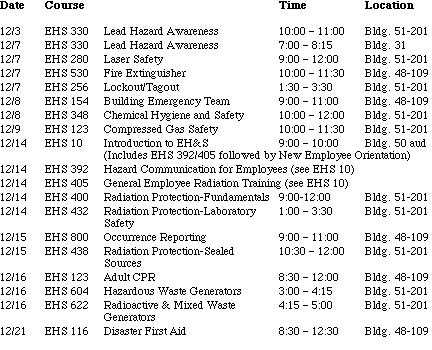
For more information or to enroll, contact Susan Aberg at Saberg@lbl.gov or enroll via the web at http://www-ehs.lbl.gov/ehstraining/registration/. Preregistration is required for all courses except EHS 10 (Introduction to EH&S). Times and locations are subject to change. For a full, updated schedule of EH&S training sessions see http://www-ehs.lbl.gov/schedule/.
New Power Station Goes Up
|
|
Flea Market
Autos /Supplies
`96 Ford XLT Extended Cab Ranger, $9,500, low Kelly Blue Book, 48K, meticulous maint, all heavy duty options, white, alloys, Michelins, bed liner, cloth bucket seats, Eric, X5486`94 FORD Taurus, 56K, 4 dr sedan, alarm, ac, ABS, cruise, Peter, X5983, Patricia, (925) 687-1827
`93 JEEP Grand Cherokee Ltd, ac, pwr steer/wndw/lock, tilt wheel, cruise, am/fm/cd, premium sound, ABS (4-wheel), leather, dual pwr seats, roof rack, privacy glass, towing pkg, alloy wheels, Kelley Blue Book, $15,190, asking $11,995/bo, William, X5785, 532-0782
'92 FORD Escort Wagon, 92K mi, am/fm, ac, exec cond, full maint, documentation, orig owner, no accidents, well maint, $3,800, Alex, X6849, (925) 945-1131
`91 FORD Probe, 102K miles, manual trans, 5 dr, very good cond, runs great, blue, new tires, am/fm/cass, $2,600, Thomas, X2230, 644-3109
`91 EAGLE Talon TSI, awd, turbo, 2 dr coupe, blue w/ silver trim, new turbo and other upgrades, 94K, photo avail, $4,400/bo, David, 642-2516, 236-9383
`90 HONDA Civic EX, 4 dr, 5 speed manual trans, pwr locks, wndw, light blue, 150K, runs great, $2,000/bo, Simon, X5446, X4581, 649-1680
`89 BLAZER Silverado, 102K, am/fm/cass, power everything, towing pkg, grill guard, roof rack, privacy glass, off-road tires, ac, tilt wheel, runs great, must sell, $7,500/bo, Sharon, X5430
`87 NISSAN Maxima GXE, 4 dr, sunroof, 2-tone gray, 112K mi, $3,500, Art, 237-4654
`83 VW Westfalia Camper, new engine, brakes, tires, rebuilt transm, sink, stove, fridge, white exterior, sec owner, runs great, clean, smogged, $5,000/bo, Stefan, X2376, 528-1127
`81 HONDA Trail CT110, 3300K, exc cond, $975/bo, Steve, X7855, (925)682-6008
`79 VOLVO 245 wagon, new tires, many new parts, works well, smogged, $1,500, Stefan, X2376, 528-1127
`76 OLDSMOBILE Cutlass Supreme, 4 dr sedan, auto, 78K, am/fm, ac, pwr steer/brks/wndws/seats, well kept interior, very good cond, runs great, $1,100, Rose, X5124
`67 MGB Roadster, runs, restoration started, new tires, new gas tank, restored wire wheels, $2,300/bo, Steve, X7855, (925) 682-6008
Motorcycle
`80 KAWASAKI LTD 1000, blue, 11K mi, runs well, needs some work, $400/bo, Eloy, X6968, 865-3896Housing
BERKELEY, short-term rental, 12/6 - 1/10, beautiful 2 bdrm, fully furn apt in Victorian house near Berkeley Bowl Market, $1,200 for entire period or $300/week, Ann, X6985, 845-2052OAKLAND, available Dec 15, 2 bdrm/1 bath, newly remodeled kitchen, new carpets, refrig, fenced backyard, $950/mo, 15 mins from Lab, Barbara, X7840, (925) 939-7754 (after 6 pm)
BERKELEY, 1 bdrm in-law apt, half block from bus, north Grizzly Peak Blvd, unfurn, private garden entrance, fireplace, non-smoker, $900/mo include util, laundry facil, Barbara or Bill, 524-5780
BERKELEY, share rental, new luxury apt, 1 year old, 2 bdrm/ 2baths, convenient to UCB, shopping, N. Berkeley BART, full modern kitchen, washer/dryer, quiet, large private balcony, off-street parking, mostly unfurn, month-to-month lease, $695/month, Stephen, X7037, 527-2891
Miscellaneous
GLASS TABLE and four blue velour chairs, $50; hamster habitrail accessories, $20; Aprica double stroller, $125; Century infant car seat, $15; Graco battery infant swing, $20, Peter or Patricia, (925) 687-1827AVIATION MAGAZINES, husband's lifetime collection of over 900 historical aviation magazines, many very early copies, good cond, bound volumes of Model Airplane News, 1932 to 1967, bound volumes of Wings, Airpower and Western Flying, Natalie, 524-4640
STORAGE CABINET, lge 4-door, white, $90; student desk, white, $15; Kirsten, X4697, 559-3451
COMPUTER MEMORY, 16 MB Techworks DIMM, never used, comes with lifetime warranty, $40; 256K L2 cache card for Performa 6400 and other computers $25, H Matis, X5031, 540-6718
WASHER/DRYER, stackable, Westinghouse, $60, J Klems, 528-9522
STEREO VCR, 4 heads, exc cond, $80, Thomas, X2230, 644-3109
WEDDING DRESS, brand new, Ginza Collection Design style 86078, size 10, white w/ rhinestones and pearls, unused, $400/bo, 643-1665, leave msg for David
STEREO UNIT, Sanyo, approx 10 yrs old, good working cond: turntable, tuner/double tape deck (tape #1 needs repair), $25/bo, Melissa, 665-5572 (leave msg)
PAC BELL computer system, 200MHz Pentium, 17" monitor, 4.3GB disk, 32MB RAM, CD-ROM, speakers, 56K modem, Canon printer, Windows 95, roll-away stand, $750, U Dahmen, X4627, 548-1653
DRYER, like new, 2 yrs old (used 1 year), electr GE 5 cycle, automatic, heavy duty, extra lge capacity, $200, Rob, X6370, (925) 427-7644
Wanted
HOUSING, pref quiet studio apt, Berkeley near campus or close to public transp, visiting scholar from Belgium, clean living, non-smoker, Jan 1 - March 31, up to $1,000/mo, Lut De Jonghe, X6138BICYCLE for 5-year-old grandson, leaving training wheels behind, free or very inexpensive, Don or Shirley, 527-0697
Vacation
N. LAKE TAHOE condo, avail Feb. 4-11, 3 bdr, sleeps 8, full kitchen, beachfront property, sauna, heated pool, $840 for 7 nights, Horst, X7377TAHOE KEYS at So. Lake Tahoe, house, 3 bdrm/2.5 bths, fenced yard, quiet, close to attractions, skiing nearby, great views, $150/night (2 night min), Bob, (925) 376-2211
SO LAKE TAHOE, spacious chalet in Tyrol area, close to Heavenly, peek of lake from front porch, fully furn, sleeps 8+, sunny deck, pool/spa in Club House, close to casinos, shopping, more, Maria, 724-9450
Lost & Found
LOST: Crystal necklace, black and silver, night of Craft Fair, at cafeteria or cafeteria grounds, has great sentimental value, personally irreplaceable, please call Helane, X4009, 763-4928Note: For other lost and found items call X4855.
Flea Market Ad Policy
Ads are accepted only from LBNL employees, retirees, and onsite DOE personnel. Only items of your own personal property may be offered for sale. Submissions must include name, affiliation, extension, and home phone number.
Ads must be submitted in writing -- via e-mail (fleamarket@lbl.gov), fax (X6641), or delivered/ mailed to Bldg. 65B. No ads are taken over the phone.
Ads will run one week only unless resubmitted in writing. They will be repeated only as space permits.
The deadline for the Dec. 17 issue is Friday, Dec. 10.


